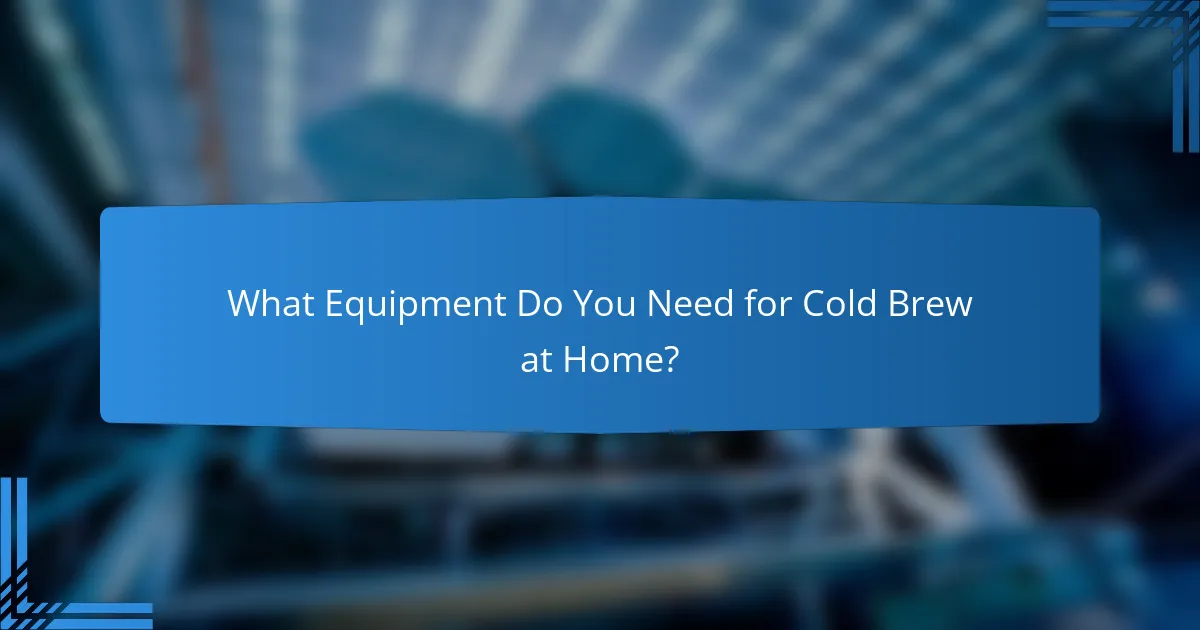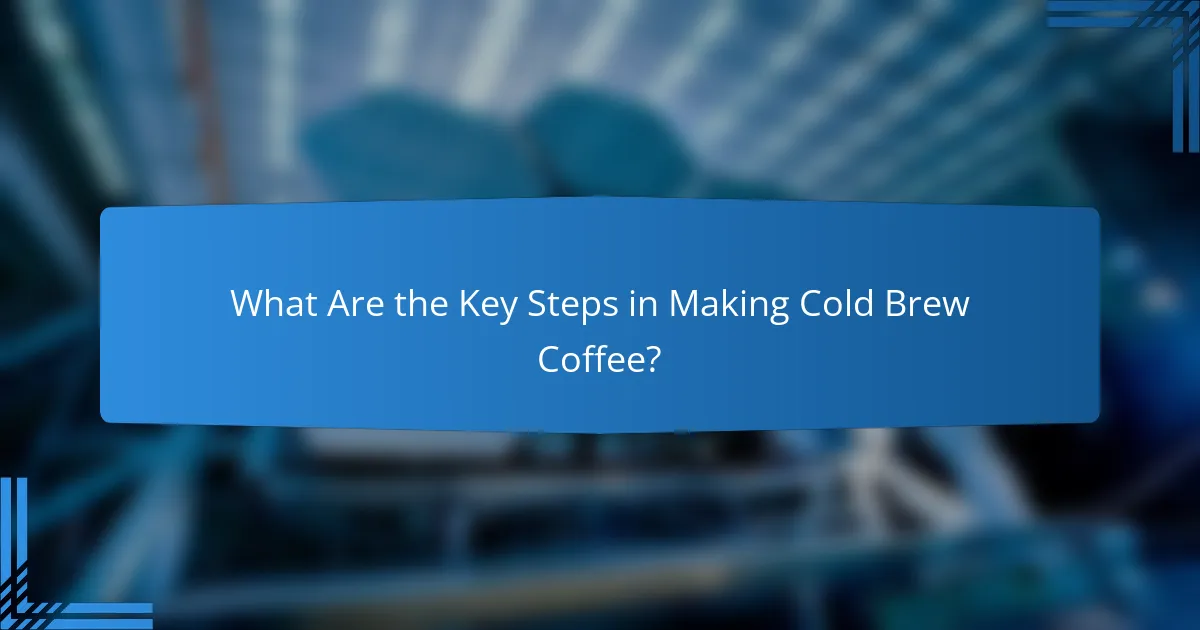Cold brew coffee offers a refreshing and smooth alternative to traditional brewing methods, making it a favorite among specialty coffee enthusiasts. By exploring various techniques and selecting the right coffee beans, you can create a rich and flavorful beverage tailored to your preferences. With the right equipment and approach, making exceptional cold brew at home is both accessible and rewarding.

What Are the Best Cold Brew Methods for Specialty Coffee?
The best cold brew methods for specialty coffee include various techniques that enhance flavor and aroma while maintaining a smooth profile. Each method has its unique process and equipment requirements, allowing you to choose one that fits your taste preferences and available resources.
Immersion Method
The immersion method involves steeping coarsely ground coffee in cold water for an extended period, typically 12 to 24 hours. This technique allows for a rich extraction of flavors, resulting in a smooth and less acidic coffee concentrate.
To use this method, combine a coffee-to-water ratio of about 1:4 to 1:8, depending on your strength preference. After steeping, strain the mixture through a fine mesh or cheesecloth to separate the grounds from the liquid.
Drip Method
The drip method utilizes a cold brew coffee maker that slowly drips water through coffee grounds over several hours. This method can produce a clean and flavorful cup, as it minimizes sediment and allows for precise control over the brewing time.
When using a drip system, a coffee-to-water ratio of 1:5 is common. Ensure the water temperature remains cold throughout the process to maintain the desired flavor profile.
French Press Method
The French press method is a straightforward approach where coarsely ground coffee is steeped in cold water for about 12 to 18 hours. After steeping, you simply press down the plunger to separate the grounds from the brewed coffee.
For this method, a ratio of 1:4 to 1:6 coffee to water works well. This method can yield a full-bodied cold brew, but be cautious of over-extraction, which can lead to bitterness.
Cold Brew Coffee Maker
Cold brew coffee makers are designed specifically for brewing cold coffee, often featuring a built-in filter system. These devices simplify the process and can produce consistent results with minimal effort.
Most cold brew makers recommend a coffee-to-water ratio of about 1:5. Follow the manufacturer’s instructions for steeping times, which typically range from 12 to 24 hours, depending on the desired strength.
Pour Over Method
The pour-over method can also be adapted for cold brew by using a slow, controlled pouring technique over coffee grounds. This method allows for precise extraction and can highlight specific flavor notes in the coffee.
For cold brew, use a coarser grind and a coffee-to-water ratio of about 1:6. Pour cold water evenly over the grounds, allowing it to drip through slowly, which can take several minutes to complete.

How Do You Choose the Right Coffee Beans for Cold Brew?
Choosing the right coffee beans for cold brew is essential for achieving a rich and flavorful beverage. Look for beans that are specifically suited for cold brewing, focusing on their origin, roast level, and grind size to enhance the final taste.
Single-Origin Beans
Single-origin beans come from one specific region or farm, offering unique flavor profiles that can elevate your cold brew. For instance, beans from Ethiopia often have fruity and floral notes, while those from Colombia may present a more balanced, nutty flavor. Experimenting with different origins can help you discover your preferred taste.
When selecting single-origin beans, consider freshness and quality. Look for beans that have been recently roasted, ideally within a few weeks, to ensure optimal flavor extraction during the brewing process.
Medium to Dark Roast
Medium to dark roast beans are generally recommended for cold brew because they provide a smoother, less acidic taste. These roasts tend to have deeper flavors and a more robust body, which can stand up well to the cold brewing method. Light roasts, while flavorful, may result in a more acidic and less balanced cold brew.
For a well-rounded cold brew, aim for a medium roast that offers a good balance of sweetness and bitterness, or a dark roast for a richer, bolder flavor. Popular choices include Colombian or Sumatra beans for their distinctive profiles.
Coarse Grind Size
A coarse grind size is crucial for cold brew, as it allows for optimal extraction without over-extraction, which can lead to bitterness. The grind should resemble sea salt or breadcrumbs, ensuring that the water can flow through the coffee grounds effectively during the steeping process.
When brewing, use a coffee-to-water ratio of about 1:4 to 1:8, depending on your taste preference. A coarser grind will help maintain a balanced flavor, so avoid fine grinds that can clog filters and create a gritty texture in your cold brew.

What Equipment Do You Need for Cold Brew at Home?
To make cold brew coffee at home, you’ll need a few essential pieces of equipment that simplify the brewing process and enhance flavor extraction. The right tools can significantly impact the quality of your cold brew, making it smoother and more enjoyable.
Cold Brew Coffee Maker
A cold brew coffee maker is specifically designed for brewing coffee with cold water over an extended period. These devices often feature a built-in filter and a large capacity, allowing you to brew several servings at once. Look for models that are easy to clean and store, as well as those made from durable materials.
When using a cold brew coffee maker, coarsely grind your coffee beans and combine them with cold or room temperature water in a 1:4 coffee-to-water ratio. Let it steep for 12 to 24 hours, then remove the filter to enjoy your brew.
French Press
A French press is a versatile tool that can also be used for cold brew. Its simple design allows for easy brewing and filtering. To make cold brew in a French press, add coarsely ground coffee and cold water in a 1:4 ratio, then stir and let it steep for 12 to 24 hours.
After steeping, press down the plunger slowly to separate the grounds from the liquid. This method is cost-effective and readily available, making it a popular choice for home brewers.
Glass Jar
A glass jar is a straightforward and accessible option for making cold brew. You can use any large jar with a lid, such as a mason jar. Combine coarsely ground coffee and cold water in a 1:4 ratio, then seal the jar and let it steep for 12 to 24 hours.
Once brewed, strain the mixture through a fine mesh sieve or a coffee filter to remove the grounds. This method is ideal for those who prefer a DIY approach and want to control the brewing process easily.
Coffee Grinder
A good coffee grinder is essential for achieving the right grind size for cold brew. Coarse grounds are necessary to prevent over-extraction and bitterness. Burr grinders are preferred over blade grinders, as they provide a more consistent grind size.
When grinding your coffee, aim for a texture similar to sea salt. This will help ensure optimal extraction during the brewing process, resulting in a smoother and more flavorful cold brew.

What Are the Key Steps in Making Cold Brew Coffee?
To make cold brew coffee, you need to follow a few essential steps: measuring coffee and water, mixing and steeping, filtering the brew, and finally serving it. Each step is crucial for achieving a smooth and flavorful cold brew that highlights the coffee’s natural characteristics.
Measure Coffee and Water
The first step in making cold brew is to measure your coffee and water. A common ratio is 1:4 to 1:8, depending on how strong you prefer your brew. For example, using 1 cup of coarsely ground coffee with 4 cups of cold water will yield a robust flavor.
Choose high-quality, freshly roasted coffee beans for the best results. Experiment with different beans to find the flavor profile that suits your taste, as various origins can produce unique notes in the final brew.
Mix and Steep
After measuring, combine the coffee grounds and water in a large container. Stir gently to ensure all the coffee is saturated. Cover the container and let it steep at room temperature or in the refrigerator for 12 to 24 hours, depending on your desired strength.
Longer steeping times generally result in a richer flavor, but be cautious not to exceed 24 hours, as this can lead to over-extraction and bitterness. Consider tasting the brew at intervals to find your ideal steeping time.
Filter the Brew
Once steeping is complete, it’s time to filter the brew to remove the coffee grounds. You can use a fine mesh strainer, a coffee filter, or a dedicated cold brew coffee maker with a built-in filter. Pour the mixture slowly to avoid clogging the filter.
Make sure to press down gently on the grounds if using a strainer to extract as much liquid as possible. The resulting concentrate can be stored in the refrigerator for up to two weeks.
Serve and Enjoy
To serve your cold brew, dilute the concentrate with water, milk, or a milk alternative to achieve your preferred strength. A common recommendation is to mix equal parts cold brew and water, but you can adjust this based on your taste.
Serve over ice and add sweeteners or flavorings as desired. Enjoy your homemade cold brew as a refreshing beverage any time of day, knowing it can be customized to fit your personal preferences.

What Are the Common Mistakes to Avoid in Cold Brewing?
Avoiding common mistakes in cold brewing is essential for achieving a smooth and flavorful cup of coffee. Key pitfalls include using the wrong coffee grind, improper steeping times, and neglecting water quality.
Using Incorrect Coffee Grind
The grind size of your coffee beans significantly impacts the extraction process in cold brewing. A coarse grind is ideal, as it allows for a slower extraction that enhances flavor without introducing bitterness. Using a fine grind can lead to over-extraction, resulting in a harsh taste.
To achieve the best results, aim for a grind similar to raw sugar or sea salt. This size will help balance the extraction time, which typically ranges from 12 to 24 hours, depending on your taste preference. Experimenting within this range can help you find the perfect brew strength.
When preparing your cold brew, remember that consistency in grind size is crucial. Invest in a good burr grinder to ensure uniformity, which will lead to a more balanced flavor profile in your final product.
